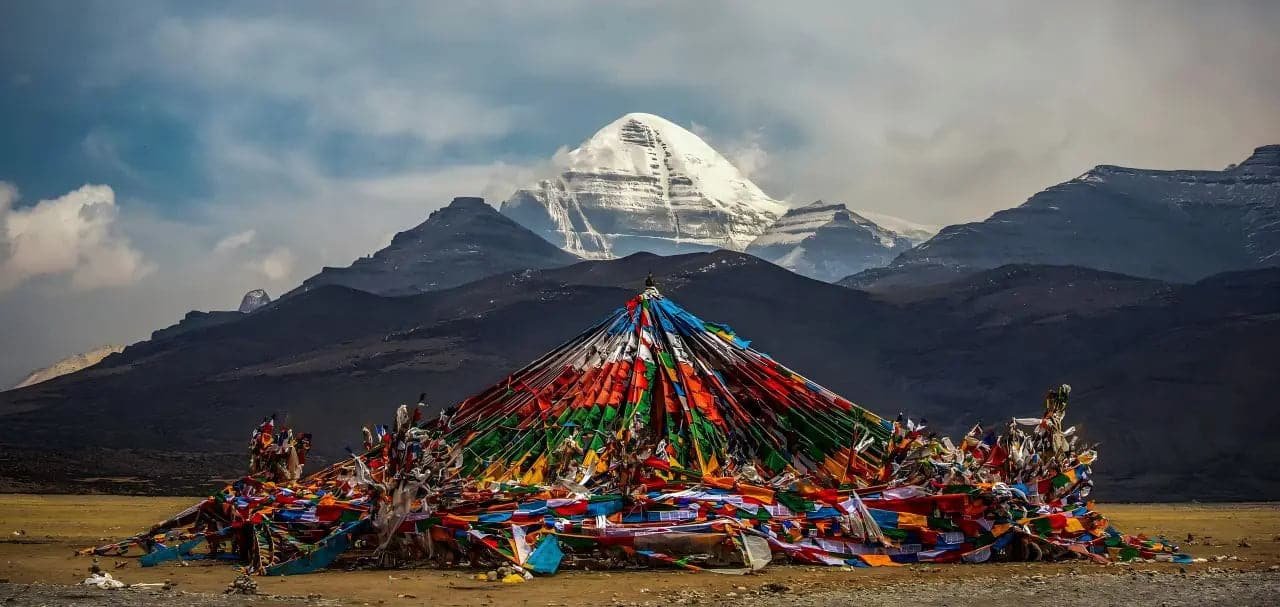Mount Kailash: A Life Hymn at the Center of the World, a Celestial Beacon of Value

Longitude 81.3° E, Latitude 31° N
Mount Kailash(གངས་རིན་པོ་ཆེ)sacred center
Why is Mount Kailash considered the Center of the World?
Mount Kailash, revered by multiple religions and cultures, is known as the “Center of the World.” This sacred status results from a unique blend of geography, religion, culture, and history.
Religious Reverence and Mythology
Mount Kailash holds deep significance for several major religions. Moreover, its spiritual influence spans across cultures and millennia:
- Tibetan Buddhism regards it as Mount Meru, the cosmic axis and the dwelling place of Demchok (Chakrasamvara), symbolizing infinite happiness. Pilgrims believe each step of the kora (circumambulation) purifies karmic debts and leads to spiritual liberation.
- Hinduism venerates it as Lord Shiva’s home, the god of destruction and rebirth. Furthermore, ancient scriptures like the Puranas describe Shiva’s meditative presence here, making it a supreme spiritual destination.
- Bon Religion, Tibet’s indigenous faith, teaches that Kailash houses 360 deities and marks the birthplace of Tonpa Shenrab.
- Jainism reveres Mount Kailash (Ashtapada) as the site where the first Tirthankara attained liberation.
In addition, myths and ancient texts, such as the Ramayana and the Kangdise Records, trace Kailash’s worship back over three millennia.

Unique Geography and Mystical Features
Four Sacred Rivers:
Mount Kailash serves as the birthplace of four rivers, each associated with a sacred animal:
- The Lion Spring River flows westward, forming the Indus.
- The Peacock River rushes south, feeding the Ganges.
- The Horse Spring River heads east into the Yarlung Tsangpo.
- The Elephant Spring River meanders back into the Indus.
Consequently, these rivers nourish vast civilizations and carry deep spiritual significance.
Unique Mountain Shape:
The mountain exhibits a pyramid-like symmetry. Eternal snow caps its summit, while its southern face displays a natural swastika, symbolizing spiritual eternity.
Mystical Snow Phenomena:
Strangely, snow persists on the sunlit side, yet the shaded side remains nearly bare. Naturally, many pilgrims interpret this as a divine sign.

Historical Pilgrimage Traditions
The sacred kora, spanning 52 kilometers, remains central to believers’ practice. Tibetan Buddhists assert that completing one kora purifies a lifetime of sins.After the fall of the Tibetan Empire, the Kingdom of Guge revitalized Buddhism around Mount Kailash by inviting masters like Atisha.
Unverified Mysteries and Legends
In 1990, a Russian team claimed that Mount Kailash was a man-made pyramid. They reported odd phenomena, such as rapid aging.Other tales suggest Nazi expeditions searched for the mythical “Shambhala Cave” beneath Kailash to access Earth’s spiritual axis.Although these theories remain speculative, they highlight Kailash’s global mythological status.
A Symbol of Spiritual Unity and Cultural Diversity
Mount Kailash embodies more than physical majesty. Instead, it serves as a spiritual nexus where humanity’s longing for meaning, salvation, and transcendence converge.Its “Center of the World” status reflects a shared spiritual aspiration across civilizations.Today, Mount Kailash shines as an eternal beacon of spiritual value.
✨ Discover the sacred energy of Mount Kailash through our curated collection of crystals and Tibetan spiritual jewelry. → [www.kailashsoul.com]

FAQs About Mount Kailash
What is the significance of Mount Kailash? Mount Kailash is considered the spiritual center of the world by multiple religions, symbolizing divine connection, cosmic power, and spiritual purification
What is a Kora around Mount Kailash? A Kora is a sacred circumambulation around Mount Kailash. Completing one full circle is believed to cleanse a lifetime of sins.
Is Mount Kailash a man-made pyramid?There are unverified theories suggesting Mount Kailash is a massive ancient pyramid, but no scientific evidence supports this claim.
Can anyone visit Mount Kailash? Yes, but it requires significant preparation due to high altitude and remote location. It remains a challenging yet deeply rewarding pilgrimage.
